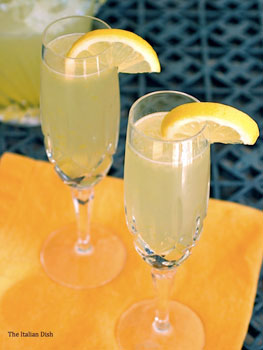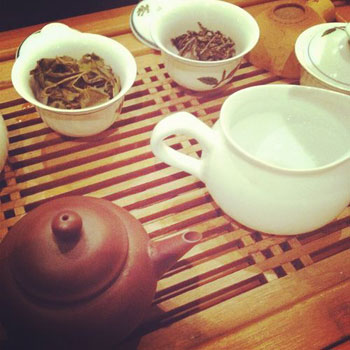 You heard me. This wine, which is made from the muscat grape in a
frizzante-style (mildly bubbly) in the Piedmont region of Italy, is one you should get
to know. Even though I drink a lot of wine – from sparkling
to port – it's easy to forget about Moscato. Mostly because I don't
often get the opportunity to drink it. I'm the only person I know who
loves dessert wine, so it's hard to justify opening a bottle to drink
all by myself. I have, it's just not something one should make a habit
of. Usually I have to quench my cravings for this delicate, fizzy
confection when I'm out to dinner. While everyone else digs into the
chocolate cake or bread pudding, I satisfy my sweet tooth by sipping.
All the pleasure, none of the fat.
You heard me. This wine, which is made from the muscat grape in a
frizzante-style (mildly bubbly) in the Piedmont region of Italy, is one you should get
to know. Even though I drink a lot of wine – from sparkling
to port – it's easy to forget about Moscato. Mostly because I don't
often get the opportunity to drink it. I'm the only person I know who
loves dessert wine, so it's hard to justify opening a bottle to drink
all by myself. I have, it's just not something one should make a habit
of. Usually I have to quench my cravings for this delicate, fizzy
confection when I'm out to dinner. While everyone else digs into the
chocolate cake or bread pudding, I satisfy my sweet tooth by sipping.
All the pleasure, none of the fat.
Yes, muscat grapes make super-ripe, overtly-fruity, wildly-perfumed
wines, but that's why they are so good with dessert. This family of
grapes is grown all over the world and is one of the oldest recorded
varietals, yet it fails to get any respect. Sure there are bad versions
out there, but that's true with every grape. What I fail to understand
is the complaints that it's too sweet…even versions that are fermented
dry. A criticism I find fairly hollow coming from the mouths of people
who drink soda, juice and sugar-laden caramel frappuccinos.
Food, Wine, Good (and Evil) Spirits
Food, Wine, Good (and Evil) Spirits
Sangria Sans-Fruit
 With summer in full swing there’s no better drink to sip by the pool than sangria. Filled with fruit, it seems less “boozy” and perhaps slightly “healthy”, so if you start drinking it before Happy Hour there seems to be less shame and guilt involved. Believe me the fruit only masks the alcohol, but who cares? It’s a drink I find hard to resist.
With summer in full swing there’s no better drink to sip by the pool than sangria. Filled with fruit, it seems less “boozy” and perhaps slightly “healthy”, so if you start drinking it before Happy Hour there seems to be less shame and guilt involved. Believe me the fruit only masks the alcohol, but who cares? It’s a drink I find hard to resist.
While I always have wine in the house, I am not a big fruit lover. Sure, if someone else brings it all bright and juicy and already cut up, I’ll generally eat my fair share, but I’m more attracted to the “idea” of it than its physical reality. Plus, I’m more a cheesy/salty person. Sweets of any kind just don’t float my boat.
Sgroppino - Italian After Dinner Drink
 In Italy, digestivos are commonly drunk after the meal and when we were in Sicily, we certainly had our share of Averna after meals. But this digestive is drunk in the Venetian region of Italy and is bright, fresh and clean. A sgroppino
is made by whipping together Italian Prosecco, lemon sorbet and vodka.
Sgroppino means "to untie" as in, to "untie your stomach" after a meal.
So you have a great excuse to make these after dinner! But hey,
these are so refreshing we drink them on a hot summer day before dinner.
In Italy, digestivos are commonly drunk after the meal and when we were in Sicily, we certainly had our share of Averna after meals. But this digestive is drunk in the Venetian region of Italy and is bright, fresh and clean. A sgroppino
is made by whipping together Italian Prosecco, lemon sorbet and vodka.
Sgroppino means "to untie" as in, to "untie your stomach" after a meal.
So you have a great excuse to make these after dinner! But hey,
these are so refreshing we drink them on a hot summer day before dinner.
Some versions of this drink use gelato but most use sorbet, which has no dairy. When you make this drink, don't use a blender – whisk in the sorbet by hand so that it retains some of its texture. You don't want it too thick, but you don't want it real thin, either.
The Best Fresh Lime Margarita
The real secret to a great Margarita is choosing the best tequila, so save these for special occasions with just a few friends. Start this recipe the day before your party – it’s worth it. The longer the zest and juice mixture is allowed to steep, the more developed the citrus flavors in the finished margaritas - the full 24 hours is best, although the margaritas will still be great if the mixture is steeped only for the minimum 4 hours.
 Classic Fresh Lime Margarita
Classic Fresh Lime Margarita
4 teaspoons grated lime zest
1/2 cup lime juice from 2 to 3 medium limes
4 teaspoons grated lemon zest
1/2 cup lemon juice from 2 to 3 medium lemons
1/4 cup superfine sugar
pinch table salt
2 cups crushed ice
1 cup 100 percent agave tequila , such as Don Julio Reposado Tequila
1/4 cup Grand Marnier
1/4 cup Triple Sec
Combine lime zest and juice, lemon zest and juice, sugar, and salt in large liquid measuring cup; cover with plastic wrap and refrigerate until flavors meld, 24 hours.
Divide 1 cup crushed ice between 4 or 6 margarita or double old-fashioned glasses. Strain juice mixture into 1-quart pitcher or cocktail shaker. Add tequila, Grand Marnier, and Triple Sec, and remaining crushed ice; stir or shake until thoroughly combined and chilled, 20 to 60 seconds. Strain into ice-filled glasses; serve immediately.
– Recipe courtesy of Cook Like James
My Favorite Tea: High Mountain Oolong
 We all have those incredible sensory memories where just the slight aroma sends us back to a treasured moment. Our minds are suddenly flooded with images and a sense of time and place that once was. While I have many of those memories tucked away in my heart, there is one in particular that plays to a tea tune.
We all have those incredible sensory memories where just the slight aroma sends us back to a treasured moment. Our minds are suddenly flooded with images and a sense of time and place that once was. While I have many of those memories tucked away in my heart, there is one in particular that plays to a tea tune.
It was one of those perfect fall days in New York where the air was crisp but nowhere near close to cold. Running down the streets of SoHo to meet a dear friend, I found her waiting with a smile in front of In Pursuit of Tea’s shop (which I must sadly say is no longer open). We opened the glass door to the tiny store with exposed brick walls that seemed to glow like autumn leaves on the treeless street.
Shelves were lined with traditional cups and teapots, and a blackboard displayed what teas were being sampled that day. Within seconds, my whirlwind of joy calmed as my eyes settled on the word “oolong” written across the board. For those of you who have followed me on my tea journey, you know that oolong tea makes my heart sing. I turned to face the woman pouring tea from a gaiwan and gently approached her. She extended a delicate cup and before I brought the sip to my lips, I heard her share that it was their “high mountain oolong tea.” Even though I was grounded in fall just moments ago, my senses shifted to spring as the floral notes escaped through the steam. With just one sip I found myself lost in a field of honeysuckle flowers. It was at that very moment that I knew I had found a treasured tea, a transformative tea.
Welcome to the new One for the Table ...
Our Home Page will be different each time you arrive.
We're sure you'll find something to pique your interest...

